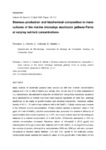Mostrar o rexistro simple do ítem
Biomass production and biochemical composition in mass cultures of the marine microalga Isochrysis galbana Parke at varying nutrient concentrations
| dc.contributor.author | Fábregas, Jaime | |
| dc.contributor.author | Herrero, Concepción | |
| dc.contributor.author | Cabezas, Buenaventura | |
| dc.contributor.author | Abalde, Julio | |
| dc.date.accessioned | 2015-09-09T15:56:55Z | |
| dc.date.available | 2015-09-09T15:56:55Z | |
| dc.date.issued | 1986 | |
| dc.identifier.citation | Fabregas J, Herrero C, Cabezas B, Abalde J. Biomass production and biochemical composition in mass cultures of the marine microalga Isochrysis galbana Parke at varying nutrient concentrations. Aquaculture 1986;53(2):101-13. | es_ES |
| dc.identifier.issn | 0044-8486 | |
| dc.identifier.uri | http://hdl.handle.net/2183/14913 | |
| dc.description.abstract | Mass cultures of Isochrysis galbana were carried out with four nutrient concentrations ranging from 2 to 16 mM of NaNO3 and salinity 35‰. An air flow of 15 l/min maintained a CO2 transference rate sufficient to keep the pH below 8.4. Using these conditions, equations were calculated by a multiple non-linear least squares regression of order four, enabling predictions to be made of growth kinetics and chemical composition. Maximum cellular density of 65.5 × 106 cells/ml was obtained with 4 mM NaNO3. Cellular volume was constant in the different nutrient concentrations. Protein content reached a maximum value of 374 μg/ml at 4 mM of NaNO3, and this concentration also presented the maximum efficiency of transformation from nitrate to protein, i.e. 114%. As a result, lowest costs for harvesting are obtained at a nutrient concentration of 4 mM NaNO3. Efficiencies decreased to 15% as nutrient concentration increased. Maximum values of chlorophyll a (21.9 μg/ml) and carbohydrates (213 μg/ml) were also obtained with 4 mM NaNO3. In the logarithmic phase, the contents of protein, chlorophyll a, carbohydrates, RNA and DNA per cell were constant. Chlorophyll a reached values between 0.15 and 0.33 pg/cell in the stationary phase. Carbohydrate levels reached the maximum value of 3.16 pg/cell with 4 mM NaNO3 in the stationary phase. The levels of RNA/cell and DNA/cell were constant in all the nutrient concentrations tested and in both growth phases, and ranged from 1.15 to 1.71 pg/cell for RNA and from 0.006 to 0.014 pg/cell for DNA. Growth in mass cultures is closely coupled to changes in nutrient concentrations and variations occur in protein, chlorophyll a and carbohydrate contents, showing differences of 177%, 220% and 136%, respectively, in the stationary phase. This biochemical variability, mainly in protein content, must have a marked effect on the nutritive value of this microalga as a feed in mariculture. | es_ES |
| dc.language.iso | eng | es_ES |
| dc.publisher | Elsevier Science Publishers | es_ES |
| dc.relation.uri | http://dx.doi.org/10.1016/0044-8486(86)90350-9 | es_ES |
| dc.subject | Isochrysis galbana | es_ES |
| dc.subject | Nutrient concentrations | es_ES |
| dc.subject | Biomass production | es_ES |
| dc.subject | Biochemical composition | es_ES |
| dc.subject | Culturee | es_ES |
| dc.subject | Marine microalgae | es_ES |
| dc.title | Biomass production and biochemical composition in mass cultures of the marine microalga Isochrysis galbana Parke at varying nutrient concentrations | es_ES |
| dc.type | info:eu-repo/semantics/article | es_ES |
| dc.rights.access | info:eu-repo/semantics/openAccess | es_ES |






